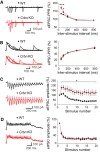Cereblon Maintains Synaptic and Cognitive Function by Regulating BK Channel
- PMID: 29530986
- PMCID: PMC6596048
- DOI: 10.1523/JNEUROSCI.2081-17.2018
Cereblon Maintains Synaptic and Cognitive Function by Regulating BK Channel
Abstract
Mutations in the cereblon (CRBN) gene cause human intellectual disability, one of the most common cognitive disorders. However, the molecular mechanisms of CRBN-related intellectual disability remain poorly understood. We investigated the role of CRBN in synaptic function and animal behavior using male mouse and Drosophila models. Crbn knock-out (KO) mice showed normal brain and spine morphology as well as intact synaptic plasticity; however, they also exhibited decreases in synaptic transmission and presynaptic release probability exclusively in excitatory synapses. Presynaptic function was impaired not only by loss of CRBN expression, but also by expression of pathogenic CRBN mutants (human R419X mutant and Drosophila G552X mutant). We found that the BK channel blockers paxilline and iberiotoxin reversed this decrease in presynaptic release probability in Crbn KO mice. In addition, paxilline treatment also restored normal cognitive behavior in Crbn KO mice. These results strongly suggest that increased BK channel activity is the pathological mechanism of intellectual disability in CRBN mutations.SIGNIFICANCE STATEMENTCereblon (CRBN), a well known target of the immunomodulatory drug thalidomide, was originally identified as a gene that causes human intellectual disability when mutated. However, the molecular mechanisms of CRBN-related intellectual disability remain poorly understood. Based on the idea that synaptic abnormalities are the most common factor in cognitive dysfunction, we monitored the synaptic structure and function of Crbn knock-out (KO) animals to identify the molecular mechanisms of intellectual disability. Here, we found that Crbn KO animals showed cognitive deficits caused by enhanced BK channel activity and reduced presynaptic glutamate release. Our findings suggest a physiological pathomechanism of the intellectual disability-related gene CRBN and will contribute to the development of therapeutic strategies for CRBN-related intellectual disability.
Keywords: BK channels; CRBN; intellectual disability; neurotransmitter release; presynaptic.
Copyright © 2018 the authors 0270-6474/18/383571-13$15.00/0.
Conflict of interest statement
The authors declare no competing financial interests.
Figures









Comment in
-
Cereblon Regulates BK Channel Expression at Presynaptic and Postsynaptic Sites in Excitatory Synapses.J Neurosci. 2018 Sep 12;38(37):7932-7934. doi: 10.1523/JNEUROSCI.1402-18.2018. J Neurosci. 2018. PMID: 30209203 Free PMC article. No abstract available.
Similar articles
-
Cereblon-Based Small-Molecule Compounds to Control Neural Stem Cell Proliferation in Regenerative Medicine.Front Cell Dev Biol. 2021 Mar 11;9:629326. doi: 10.3389/fcell.2021.629326. eCollection 2021. Front Cell Dev Biol. 2021. PMID: 33777938 Free PMC article. Review.
-
Rescue of Learning and Memory Deficits in the Human Nonsyndromic Intellectual Disability Cereblon Knock-Out Mouse Model by Targeting the AMP-Activated Protein Kinase-mTORC1 Translational Pathway.J Neurosci. 2018 Mar 14;38(11):2780-2795. doi: 10.1523/JNEUROSCI.0599-17.2018. Epub 2018 Feb 19. J Neurosci. 2018. PMID: 29459374 Free PMC article.
-
CRL4 antagonizes SCFFbxo7-mediated turnover of cereblon and BK channel to regulate learning and memory.PLoS Genet. 2018 Jan 25;14(1):e1007165. doi: 10.1371/journal.pgen.1007165. eCollection 2018 Jan. PLoS Genet. 2018. PMID: 29370161 Free PMC article.
-
BK channel blocker paxilline attenuates thalidomide-caused synaptic and cognitive dysfunctions in mice.Sci Rep. 2018 Dec 5;8(1):17653. doi: 10.1038/s41598-018-36367-3. Sci Rep. 2018. PMID: 30518785 Free PMC article.
-
Synaptic dysfunction and intellectual disability.Adv Exp Med Biol. 2012;970:433-49. doi: 10.1007/978-3-7091-0932-8_19. Adv Exp Med Biol. 2012. PMID: 22351067 Review.
Cited by
-
Life mimics art.Cell Res. 2023 Apr;33(4):267-268. doi: 10.1038/s41422-022-00765-0. Cell Res. 2023. PMID: 36646761 Free PMC article. No abstract available.
-
The CB1 receptor interacts with cereblon and drives cereblon deficiency-associated memory shortfalls.EMBO Mol Med. 2024 Apr;16(4):755-783. doi: 10.1038/s44321-024-00054-w. Epub 2024 Mar 21. EMBO Mol Med. 2024. PMID: 38514794 Free PMC article.
-
Cereblon-Based Small-Molecule Compounds to Control Neural Stem Cell Proliferation in Regenerative Medicine.Front Cell Dev Biol. 2021 Mar 11;9:629326. doi: 10.3389/fcell.2021.629326. eCollection 2021. Front Cell Dev Biol. 2021. PMID: 33777938 Free PMC article. Review.
-
Cereblon Regulates the Proteotoxicity of Tau by Tuning the Chaperone Activity of DNAJA1.J Neurosci. 2021 Jun 16;41(24):5138-5156. doi: 10.1523/JNEUROSCI.2494-20.2021. Epub 2021 May 10. J Neurosci. 2021. PMID: 33972400 Free PMC article.
-
Cereblon Regulates BK Channel Expression at Presynaptic and Postsynaptic Sites in Excitatory Synapses.J Neurosci. 2018 Sep 12;38(37):7932-7934. doi: 10.1523/JNEUROSCI.1402-18.2018. J Neurosci. 2018. PMID: 30209203 Free PMC article. No abstract available.
References
Publication types
MeSH terms
Substances
LinkOut - more resources
Full Text Sources
Other Literature Sources
Molecular Biology Databases
Research Materials
